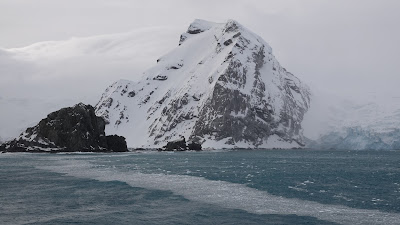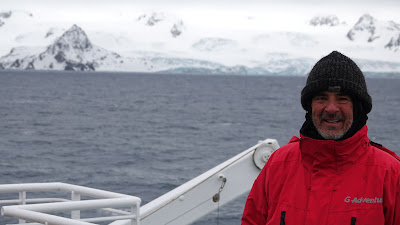Elephant Island where Shackelton sailed to on three small lifeboats after the Endurance sank.
This is Wild Point where he left his first mate Wild and the others while he went for help.
They were stuck here for months (behind that black rock)!
Goodbye Elephant Island.
Bruce, John and Chris or 'Patch'.
The beautiful blue of icebergs.
Lookout Point, Elephant Island
Wednesday, November 6th.
Elephant Island
We were woken this morning by an
announcement that we were approaching Elephant Island. We got dressed in our
winter clothes as it was -4 degrees on deck and went out. There is was with
clear visibility! Elephant Island. This is the island that Ernest Shackelton
sailed to in 1915 with 25 sailors in three wooden row boats after their ship
the Endurance was trapped in the ice and sank. It took them seven days and
nights to row here as the pack ice was breaking up. This point is names after
the man he left in charge: Frank Wild. He left 19 men for months as he and five
of the strongest, healthiest ones sailed and rowed for eight hundred miles over
the frigid, dangerous Southern Ocean to South Georgia Island for help. What a
dismal and foreboding place! An incredible story of adventure, survival and
endurance. If the men were still here, they would be amazed at us sailing up in
the Expedition, coming out on deck to take photos and then retiring inside for
a buffet breakfast. What a difference a 100 years makes! We approached Wild
Point where the men were camped under two overturned wooden boats all through
the Antarctic winter. As we stood on deck taking photos we were buffeted by 42
knot wind gusts that threatened to blow us off. I’ve read the book, but to see
the actual spot where they were stuck was beyond belief or comprehension. How
they survived here for that long and not even knowing if Shackelton survived or
not and was even coming back, is beyond incredible!
We could not land or go out on the
Zodiacs because of the winds and the swell.
After breakfast we sailed around
Elephant Island to Lookout Point, but couldn’t disembark there either. The
conditions were just too rough and dangerous. But, we enjoyed a lot of amazing
views of mountains covered in ice, glaciers and icebergs. Stunning views and
exactly why we are all here.
Keith Mountain lecture:
The Climate of Antarctica and the
Southern Oceans.
The details of this lecture are at
the end of the post.
Then they showed a stupid American
movie ‘The Big Year’. I watched about ten minutes and retired to our room to do
some work on photos.
At recap and briefing John gave us
a short history of Shackelton’s early life. Tomorrow we will be in the South
Shetland Islands.
Dinner was an Italian buffet. Afterwards we had a
choice between the second half of the whaling documentary Britain’s Whale
Hunters, The Untold Story or a concert in the Polar Bear Bar with Blaise. I
figured I could watch the movie on uTube later, so I went upstairs and sat and
talked to Mike and Jackie while having a beer. To bed by 11:00. Bruce and John
watched the movie and poor John is still feeling poorly.
Keith Mountain lecture:
The Climate of Antarctica and the
Southern Oceans.
Simply defined it is cold, dry and
windy, just about everywhere which is caused by circumpolar current and the convergence
of the polar front and the warmer oceans of the Atlantic and the Pacific. These
two conditions established a kind of physical barrier between the 40 and 60
degree south latitude. There are rapidly changes in temperature, caused by the strength
of the eastward flowing Antarctic Circumpolar Current. The Circumpolar Current
is very deep and is the largest of the global ocean currents. It moves 135
million cubic meters of water per second!
Later discoveries would recognize
equally significant changes in salinity, nutrient loading and aquatic species
and the like. The average height of Antarctica makes it the highest continent in
altitude!
The sun spins around the continent
at 23 degrees on the horizon for the summer and not at all in the winter. The
ice is so cold it reflects all of the solar heat and maintains the freezing temperature.
The interior of the continent is very dry and is the driest area of the whole
world. It is a desert. Very little precipitation ever falls but it doesn’t melt
and stays forever.
Wasn’t studied scientifically until
1957-58 where they set up 5 stations around the continent to measure temp, wind,
pressure, etc.
What is the polar front?
A persistent belt of low
atmospheric pressure surrounding the Antarctic continent.
High pressure over the continent,
globally persistent high pressure over the poles.
Low pressure winds are strongest
and most intense.
Coldest day on record -89 C July
21, 1983
Inland -40 to -70
Coastal -15 to -35
Peninsula is the warmest summer temp can reach
15











Sorry to hear John doesn't feel well hoping to read he is on the mend
ReplyDeleteQuite a story about Shackleton I remember taking all that in school but cant remember the details
I like the way things are in 2019 rather 1919